These tender, flaky Orange Cranberry Scones have a delicate orange-vanilla flavor, with dried cranberries adding a sweet-tart contrast. Top with a sweet orange glaze to complete the citrus notes for an over-the-top treat!
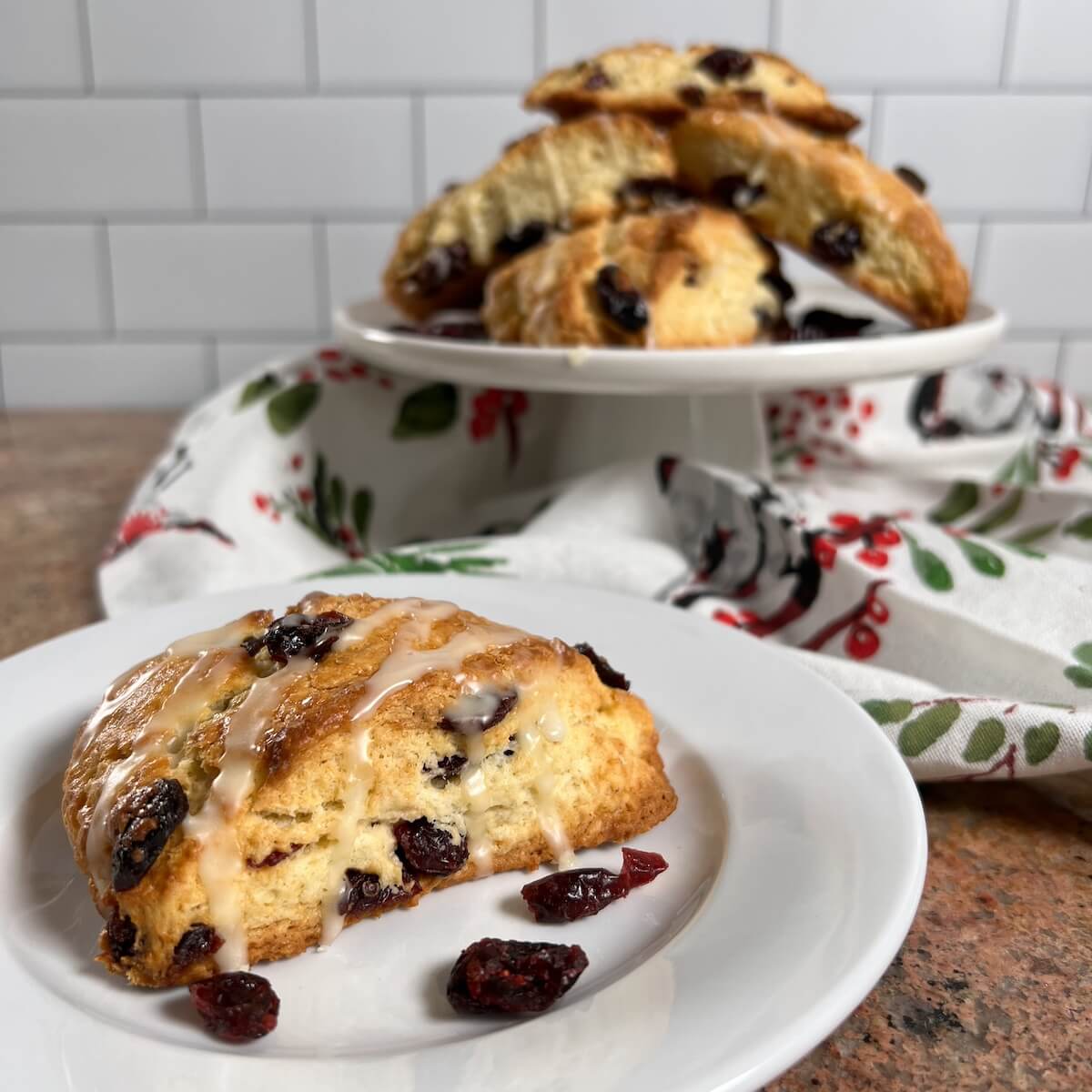
Jump to:
Why this recipe works
- These scones have a delicate orange and vanilla flavor that's complemented by sweet-tart dried cranberries
- The orange glaze adds more bright citrus notes
- Crunchy coarse sugar adds a contrasting texture to these flaky and tender scones
I enjoy playing with my food. By that I mean, taking a basic recipe and making different flavor combinations, and scones are a perfect place to start.
The beauty of a good recipe for cream scones is its adaptability. Like with Chocolate Chip Cream Scones, we can create a new scone by altering the flavorings and mix-ins. These glazed Orange Cranberry Scones are just a variation of my favorite homemade cream scones recipe.
While Fall is the perfect time to bake with fresh cranberries providing their pop of bright tartness, dried cranberry scones can be made any time of year.
Golden brown with a crunchy exterior and flaky interior, Orange Cranberry Scones recipe is a winner. The Fiori di Sicilia adds a hint of orange-vanilla flavor, but it's the dried cranberries that steal the show. I love their sweet-tart goodness!
Glazed Orange Cranberry Scones are perfect for breakfast, brunch, or for an afternoon tea. You can't go wrong serving them with clotted cream and some lemon curd or jam.
The flavors of orange and cranberry feature in classic cranberry sauce made with fresh cranberries and cinnamon, and dried cranberries star in Cranberry Cinnamon Swirl Bread. If you want more Fiori di Sicilia in your life, there's Orange Vanilla Pound Cake. Yum!
⭐⭐⭐⭐⭐
YUM!! These are my absolute favourite scones! Even better than the maple walnut ones which I wouldn't have thought was possible!
- Lyra
Recipe Ingredients
You'll need the following ingredients to make this orange cranberry scone recipe:

Ingredient Notes
The basic ingredients for scones don't vary a whole lot: all-purpose flour, heavy cream, butter, sugar, baking powder, an egg, and salt.
Butter: How you cut up your butter isn't as important as keeping it cold. Generally I'll grate frozen butter on a box grater (mostly because I don't have butter defrosted). If you'd rather, cut chilled butter into small ½-inch cubes. You can also cut chilled butter into ½-inch cubes before blending it into the flour mixture. You want the butter to stay as cold as possible, so don't overwork the dough.
Some cream scone recipes use more butter than the 3 : 1 : 2 recipe ratio. For this recipe, you can add another 2 tablespoons of butter for more richness if you'd like.
Baking powder: This scone recipe uses 1 tablespoon of baking powder to insure you'll have tall, tender scones. Don't substitute baking soda as the scones will have a metallic taste to them.
Flavoring: These orange cranberry scones get their flavor from Fiori di Sicilia, an orange vanilla extract. For even more orange flavor, consider adding 2 teaspoons of grated orange peel (the amount from 1 orange) to the dough and/or the glaze. You can't go wrong with more flavor!
You can also substitute 2 teaspoons of grated orange peel and 1 teaspoon vanilla extract for the Fiori di Sicilia.
Mix-ins: Dried cranberries add a sweet-tart contrast to these sweet scones.
Toppings: The scones are topped with a bit of coarse sugar sprinkled on before baking to add a little crunch. After cooling, drizzle an orange glaze for more citrus goodness - it's just a mixture of orange juice and powdered sugar.
See the recipe card for a full list of ingredients and measurements.
How to make orange cranberry scones
Step 1: Make the scone dough
Combine the flour, sugar, baking powder, and salt (photo 1).
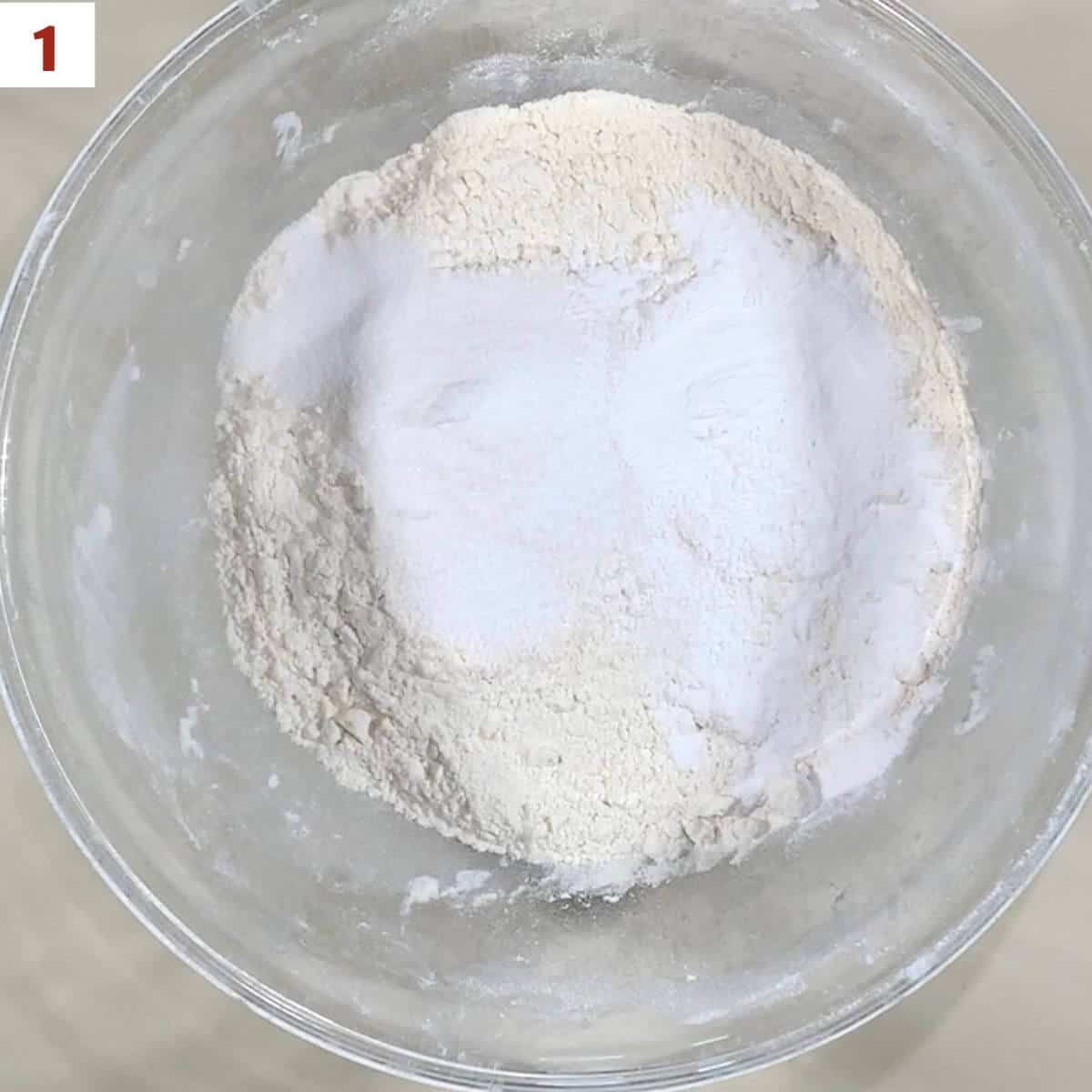
How to prepare butter for scones
It's important to keep your butter cold when making scones (or pie crust, for that matter). Working with frozen butter is even better. The reason is that the colder the butter is before hitting the oven, the crumblier the resulting scone will be.
I find it's best to grate the frozen butter with a box grater and lightly toss it with the flour as you go. The butter won't build up on your cutting board, and will be easier to cut in with the pastry blender. Plus, if you keep your butter in the freezer (as I do), there’s no need to defrost it first, and that means scones at a moment’s notice!
Alternatively, you can just cut chilled butter into small ½-inch cubes before blending it into the flour mixture.
Grate the frozen butter using a box grater and toss it into the flour mixture a little at a time. Once all the butter is grated, use a pastry blender or two forks to work the butter into the flour until coarse, pea-sized crumbs appear (photo 2).
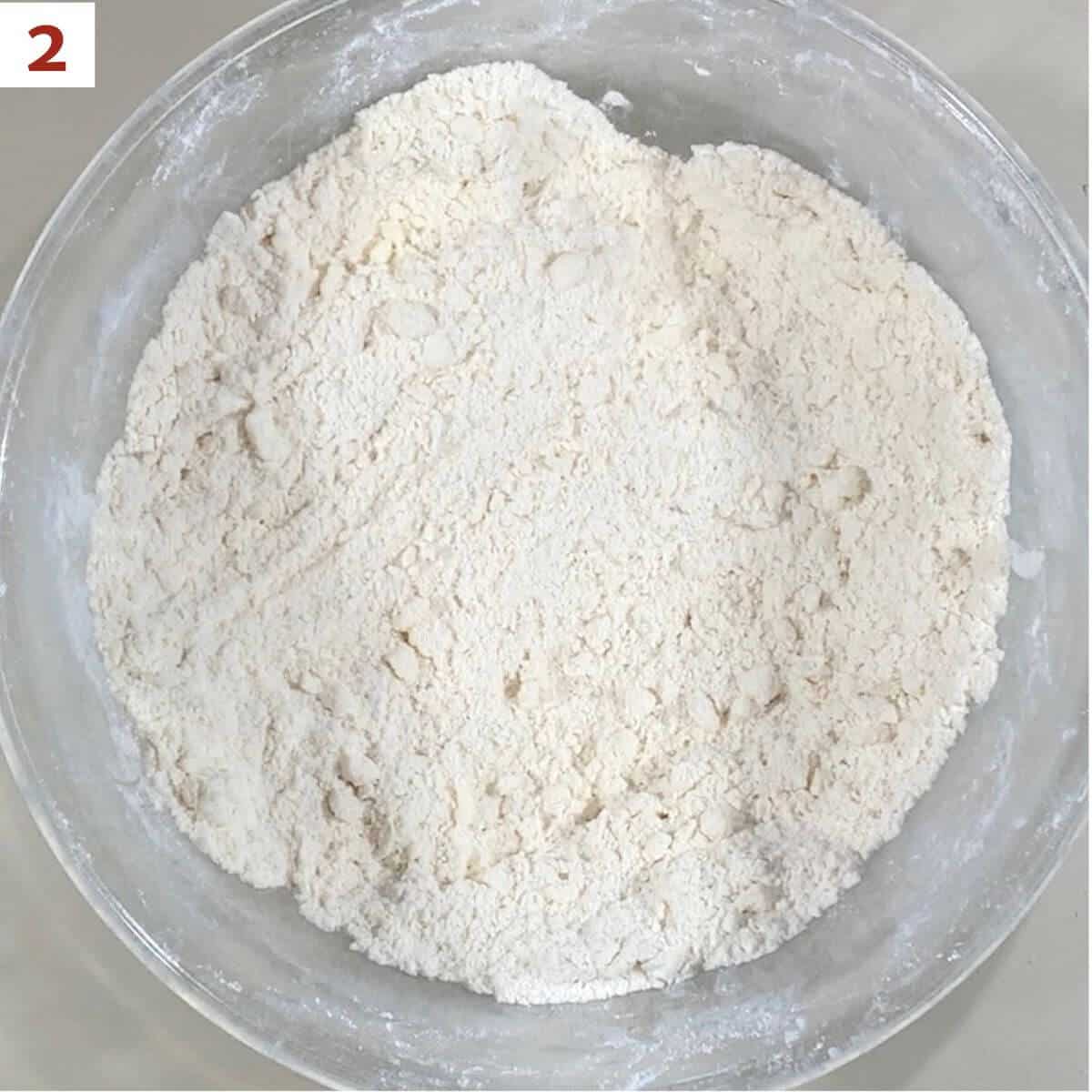
In a small bowl, whisk together the heavy cream, egg, and Fiori di Sicilia. Slowly add the heavy cream mixture to the flour mixture and mix until the dough just holds together (photo 3). Using a bowl scraper helps to keep your hands from warming the butter as the dough is mixed.

You have to be flexible about the amount of liquid to add to the flour mixture as the actual amount will depend on the humidity of the day. Squeeze a small amount of dough between your fingers and if it is very crumbly, add more liquid, 1 tablespoon at a time (2 tablespoons maximum). If the dough is too wet, you can knead in 1 tablespoon of flour when you turn out the dough. Don't over-mix the dough - you want to keep that butter cold and separate from the flour (photo 4).
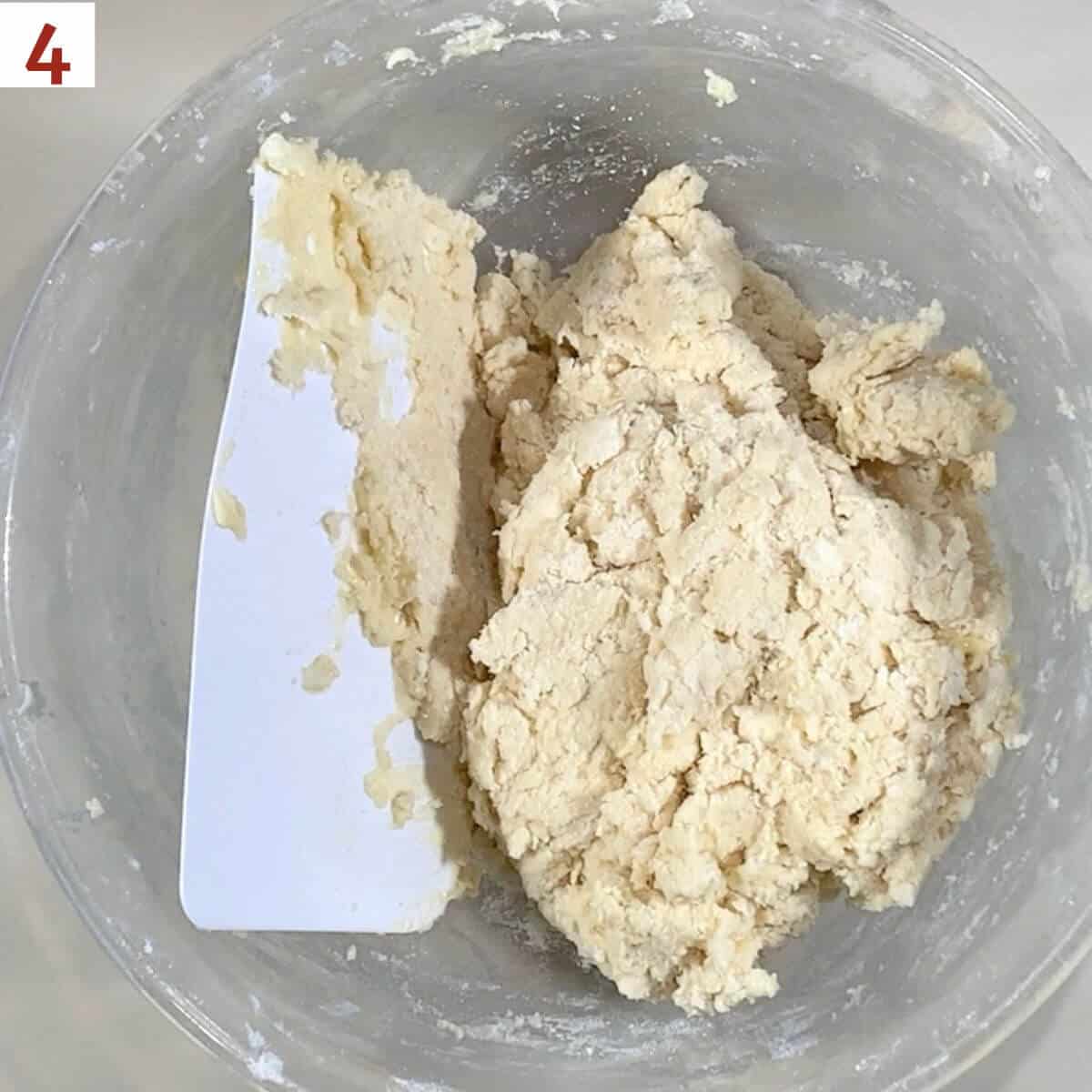
Step 2: Fold in the dried cranberries
Use the bowl scraper to push the dough into a ball in the bowl, then turn the dough out onto a lightly floured surface and shape it into a rough square about 1-inch high.
Sprinkle some of the dried cranberries on the dough, then fold it in half to seal them in (reserve some cranberries to press into the dough later). Repeat a couple more times, so the cranberries are evenly distributed in the dough (photo 5). This process is similar to how mix-ins are kneaded into bread dough.
Gather the dough, and flatten it into a 6-inch disk (if you want square scones, shape the dough into a rectangle with the short side about 4-inches long). Use a bench scraper to release the dough, if needed. Cover with plastic wrap, and refrigerate the dough at least 30 minutes or up to overnight.

Step 3: Bake the scones
Once the dough is chilled, you have your choice of how to shape the scones:
- For wedge-shaped scones: Roll out the disk into an 8-inch circle, then use the bench scraper to cut the disk into 8 wedges.
- For round scones: Roll out the disk to a height of about ¾ inches. Use a 3-inch round cookie cutter to cut out rounds (gather, press, and cut the leftover dough again as needed, but hopefully not more than 2 times).
- For square scones: Roll out the dough into a 12- by 4-inch rectangle, then cut into twelve 2-inch squares.
Place the scones about 2-inches apart on a half baking sheet pan covered in a Silpat silicone mat or parchment paper. Press in the reserved dried cranberries on the tops of the scones. Brush the tops of each scone with heavy cream with a pastry brush and sprinkle on some coarse sugar.
Bake the scones at 400°F for about 18 to 23 minutes or until golden brown (photo 6). Remove from the oven and cool the scones on the baking pan for 2 minutes, then move to a cooling rack. Allow to cool for 10 to 15 minutes.

Step 4: Glaze the scones
While the scones are cooling, sift the powdered sugar, then stir in the orange juice in a bowl until smooth. Adjust the consistency by adding 1 teaspoon of orange juice or more sifted powdered sugar as needed.
Place the cooling rack back on the baking pan to catch the drips. Drizzle the glaze on the still-warm scones and allow to set before serving (photo 7).

Storage and make-ahead instructions
Storage Instructions: Scones are best enjoyed right away, though leftover scones keep well at room temperature or in the refrigerator for about 3 to 5 days. Glazed or plain scones freeze well, up to 3 months. Thaw overnight in the refrigerator then warm to your liking before serving.
Make-ahead instructions: For freshly baked scones anytime, freeze the cut, unbaked scones in a ziplock bag. Take out as many as you want to bake (there's no need to defrost them first), and bake at 375 °F for 20 to 25 minutes.
Yield Notes
The yield is generally about 8 scones (that's what I get from a circle cut into wedges or with a 3-inch round cookie cutter), and up to 12 (cutting the square scones). Your yield may vary.
Questions asked and answered
Here are some questions you might have...
This is an orange-vanilla extract with floral undertones. Used sparingly, it lends a subtle citrus and vanilla flavor and perfume to baked goods. In this cranberry orange scone recipe, you can substitute 2 teaspoons of grated orange peel (the amount from 1 orange) and 1 teaspoon vanilla extract for the Fiori di Sicilia.
That's a big yes! It's important to have the cold butter coated with flour, but not overly mixed in. Then, as the scones are baked, the water in the butter evaporates, giving the scones a flaky, crumbly texture. Keeping the dough cold ensures that the butter won't melt too quickly, leading to dense scones.
Over-working the dough can develop the gluten in the flour too much, leading to a dry, tough scone. While we want strong gluten in bread, you'll want to mix scone dough only enough to bring the dough together.


More biscuit and scone recipes to try
Recipe
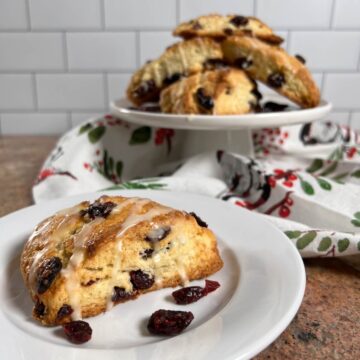
Orange Cranberry Scones
Equipment
- 3-inch round cookie cutter if desired
Ingredients
For the scones
- 2 cups all-purpose flour
- ¼ cup granulated sugar
- 1 tablespoon baking powder
- 1 teaspoon kosher salt
- 6 tablespoons unsalted butter, frozen and grated, see Recipe Notes
- ½ cup heavy cream, plus extra for brushing on top
- 1 large egg
- ¼ teaspoon Fiori di Sicilia, see Recipe Notes
- ½ cup dried cranberries
- coarse sugar, for sprinkling
For the orange glaze
- ½ cup powdered sugar
- 1 tablespoon orange juice
Instructions
- Preheat the oven to 400 °F. Line a half baking sheet pan with a Silpat silicone mat or parchment paper. Set aside.
- Make the scones: In a large bowl, combine the flour, sugar, baking powder, and salt.
- Grate the butter using a box grater and toss it into the flour mixture a little at a time. Once all the butter is grated, use a pastry blender, two forks, or your hands to work the butter into the flour until coarse, pea-sized crumbs appear.
- In a small bowl, whisk together the heavy cream, egg, and Fiori di Sicilia. Slowly add the heavy cream mixture to the flour mixture and mix until the dough just holds together. Using a bowl scraper helps to keep your hands from warming the butter as the dough is mixed.The amount of the heavy cream mixture to add depends on the humidity of the day. Squeeze a small amount of dough between your fingers, and add more of the cream mixture or flour, 1 tablespoon at a time (2 tablespoons maximum), if it's too crumbly or too wet. Remember, do not over mix the dough - you want to keep that butter cold and separate from the flour.
- Turn dough out onto a lightly floured surface and push together into a rough square. Sprinkle some of the dried cranberries on the dough, then fold it in half to seal them in (reserve some cranberries to press into the dough later). Repeat a couple more times, so the cranberries are evenly distributed in the dough.
- Gather the dough, and flatten it into a 6-inch disk (if you want square scones, shape the dough into a rectangle with the short side about 4-inches long). Use a bench scraper to release the dough, if needed. Cover with plastic wrap, and refrigerate the dough at least 30 minutes or up to overnight.
- Once the dough is chilled, you have your choice of how to shape the scones:For wedge-shaped scones: Roll out the disk into an 8-inch circle, then use the bench scraper to cut the disk into 8 wedges. For round scones: Roll out the disk to a height of about ¾ inches. Use a 3-inch round cookie cutter to cut out rounds (gather, press, and cut the leftover dough again as needed, but hopefully not more than 2 times).For square scones: Roll out the dough into a 12- by 4-inch rectangle, then cut into twelve 2-inch squares.
- Place the scones about 2-inches apart on the prepared baking pan. Press in the reserved dried cranberries on the tops of the scones. Brush the tops of each scone with heavy cream and sprinkle with coarse sugar.
- Bake for about 18 to 23 minutes or until golden brown. Remove from the oven and cool the scones on the baking pan for 2 minutes, then move to a cooling rack. Allow to cool for 10 to 15 minutes.
- Make the glaze: While the scones are cooling, sift the powdered sugar, then stir in the orange juice in a bowl until smooth. Adjust the consistency by adding 1 teaspoon of orange juice or more sifted powdered sugar as needed.
- Place the cooling rack back on the baking pan to catch the drips. Drizzle the glaze on the and allow to set.
- Serve the scones warm or at room temperature and enjoy!
- Storage Instructions: Scones are best enjoyed right away, though leftover scones keep well at room temperature or in the refrigerator for about 3 to 5 days. Glazed or plain scones freeze well, up to 3 months. Thaw overnight in the refrigerator then warm to your liking before serving.
- Make-ahead instructions: For freshly baked scones anytime, freeze the cut, unbaked scones in a ziplock bag. Take out as many as you want to bake (there's no need to defrost them first), and bake at 375 °F for 20 to 25 minutes.
- The yield is generally about 8 scones (that's what I get from a circle cut into wedges or with a 3-inch round cookie cutter), and up to 12 (cutting the square scones). Your yield may vary.





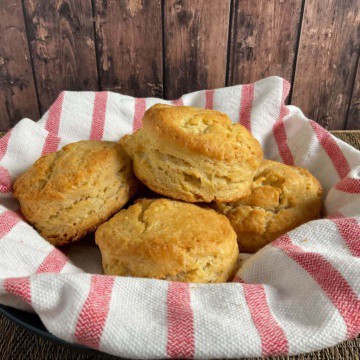


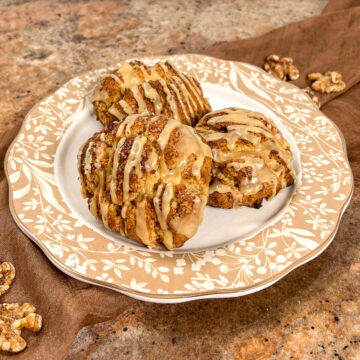
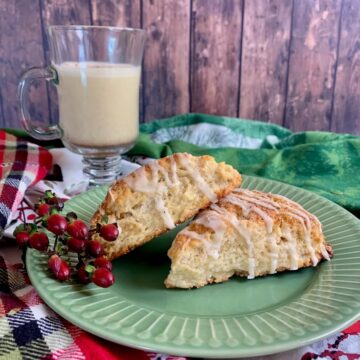


Lyra says
YUM!! These are my absolute favourite scones! Even better than the maple walnut ones which I wouldn't have thought was possible!
Tammy says
Enjoy! 😉